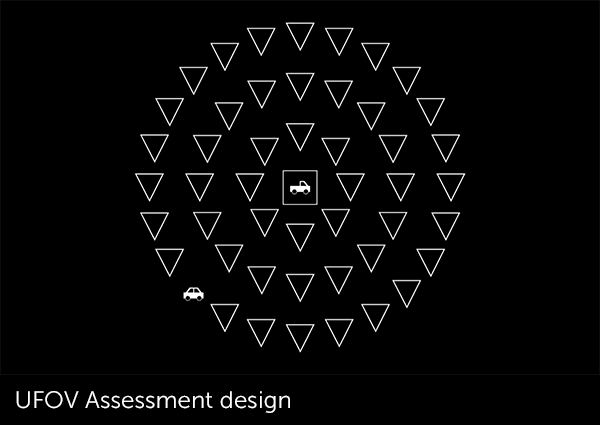The assessment and measures underlying the UFOV® technology was originally developed by Dr. Karlene Ball and Dr. Daniel Roenker and provided through a company they co-founded called Visual Awareness.
The UFOV Software Development Process
The roots for the development of the UFOV software stem from earlier work in vision and aging. In this work we were interested in the everyday visual problems of older adults, and understanding the basis for these difficulties. Many older adults reported what they termed ‘vision problems.’ They expressed difficulty in driving, walking, and other mobility related activities which were not the result of any physical impairment. For example, they reported that other cars, or even other people, surprised them and seemed to come out of nowhere. They reported difficulty finding things when a visual search was required. They reported difficulty with left hand turns, and they reported that it took longer to do things now than it used to. Other common complaints related to divided attention, and difficulty with the complexities of driving in traffic while searching for a particular street sign. Things were even worse in the presence of either background noise or lots of other signs in the vicinity.
Based on these self-reports, and a review of earlier studies on age-related difficulties with visual search, an early version of the proprietary task was developed. In this version we varied the degree of difficulty of a center task, stimulus duration (the length of time a target was available for processing), the presence of distractors in the background, and the eccentricity of peripheral stimuli. In order to generate all combinations of these factors, it required several hours of data collection per individual to obtain a baseline level of performance. We were also interested in whether practice with the task resulted in improved performance.
Through three to four years of systematic study of this task, we developed the concept of the field of vision as a spatial area. The size of this area (e.g., the window of attention) was found to vary depending on task demands within an individual. Furthermore, it was quite clear that the size of the field of vision varied greatly between older individuals. We then began to evaluate the size of the field of vision as an indicator of crash risk and other mobility problems. Through these studies it became clear that the resulting proprietary measure was clearly a better predictor of crash risk than other visual or cognitive tests we evaluated.
While further studies on the effectiveness of the UFOV test as determinant of risk factors for driving and mobility loss were underway, we sought to answer very pragmatic issues related to its use. For example, what was the minimal amount of information needed to provide a valid prediction (e.g., how could the assessment be shortened, if at all, while retaining predictive accuracy). Another question related to the number of trials needed to obtain a reliable estimate of performance. We also found that the size of the UFOV test results was in direct proportion to the stimulus duration, thereby allowing us to develop an even briefer version of the test, which was then validated against the longer version.
Use of this measure has escalated over the years as more and more researchers include the assessment in a variety of research paradigms. In addition to studies evaluating risk factors for driving, the measure obtained from the UFOV test has been used in a variety of other research studies where cognitive decline may be present. The UFOV test is consistently a better predictor of real world performance than other vision tests in part because it employs threshold targets, and evaluates visual performance under a variety of cognitive demands. Real world activities require visual processing capabilities, and the UFOV test provides a measure of this capacity.
Bringing UFOV to Posit Science
The scientists at Posit Science became aware of the work that Dr. Ball and Dr. Roenker were doing on UFOV more than a decade ago, and were impressed with the scientific rigor behind the technology. In fact, the UFOV work was based on the same foundational science and design principles that the Posit Science group was using to build the exercises that are now in BrainHQ. In 2008, the two groups decided to work together, and Posit Science acquired an exclusive license to the UFOV technology from Visual Awareness. As Dr. Ball said, “We decided to work with Posit Science because there was such a good fit scientifically and in our missions.”
The current UFOV assessment that Posit Science offers shares the same look and feel as the assessment Visual Awareness offered: a simple black and white design with cars or trucks as the target objects. The UFOV training exercise, however, has been redesigned to be more engaging and appealing to users. (After all, training on the exercise only improves speed of processing and useful field of view if people can stick to it!)
Although the look of the training exercise has changed, the core science has not: Dr. Peter Delahunt and Dr. Henry Mahncke at Posit Science worked closely with Drs. Ball and Roenker to make sure of that. Dr. Roenker carefully assessed the new exercise (now called Double Decision) to verify that the defining scientific elements—including divided attention, adaptivity, difficulty, intensity, and feedback—were consistent. What’s more, a study called PACES (Physical and Cognitive Exercise Study) that trained some people on the earlier version of UFOV training and others on the Posit Science version found both versions significantly improved visual processing speed and field of view, and that there were no significant differences between the two versions for either pre- or post-training scores.
Posit Science is delighted to be able to offer both the UFOV Assessment and UFOV training in BrainHQ. Doing so meets our mission to get the best scientific exercises and assessments into the hands of people, where they can be useful, effective tools for brain health.


